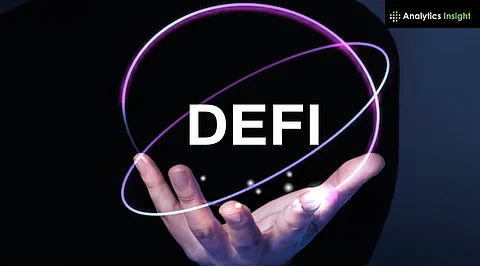

Aave, Compound, and MakerDAO continue to lead DeFi lending, backed by high TVL and security.
Morpho, Spark, and Euler introduce innovative peer-to-peer and vault-based models.
Cross-chain lending and audited protocols are crucial for navigating DeFi in 2025.
Decentralized finance’s lending sector continues to expand in 2025, enabling crypto holders to earn yield or borrow assets seamlessly via smart contracts. With over $56 billion locked in these platforms, approximately 35% of total DeFi TVL, the sector remains the bedrock of DeFi’s growth.
Here's a breakdown of the most influential lending protocols shaping the industry today.
Blockchain(s): Ethereum, Arbitrum, Optimism, Polygon, Avalanche & others
Key Features: Flash loans, variable/stable rates, collateral exchanges, RWA integration, native stablecoin GHO.
TVL: ~$43.8 billion (Aave maintains ~19% of total DeFi TVL)
Aave remains the leader in DeFi lending, combining powerful features with robust security. Its modular governance via AAVE tokens supports multi-chain growth and the incorporation of real-world assets. Aave v3’s cross-chain capabilities and focus on optimizing average collateral utilization highlight its central role. Research shows Aave v3’s automated liquidation enhancements on L2 led to higher TVL and revenue gains.
Blockchain(s): Ethereum, Arbitrum, Polygon, Base
Key Features: Algorithmic interest rates, community governance via COMP token
TVL: ~$2.3 billion active loans; remains top tier in market share
Compound pioneered algorithmic money markets. Its interest rates dynamically adjust, rewarding users through compounding cTokens. V3 (Comet) brings higher capital efficiency and optimized risk, backed by detailed simulations from Chainrisk audits.
Blockchain(s): Ethereum
Key Features: Over-collateralized lending, minting of DAI stablecoin
TVL: Leading stablecoin loan protocol (holds ~30% of market share)
MakerDAO enables users to lock collateral (like ETH) to mint DAI. Its decentralized governance ensures stability, while the ecosystem continues expanding into real-world use cases like DeFi savings and payments.
Blockchain(s): Multi‑chain EVM
Key Features: List unlisted tokens permissionlessly, vault isolation, risk-adjusted LTVs, DeFi-native rewards
TVL: Not specified, but recognized among the top 10 platforms
Euler’s permissionless listing and vault-based design mark it as a pioneer. With over 40 audits across complex architectures, Euler offers advanced lending mechanics while managing systemic risk through modular isolation and flexible borrowing limits.
Blockchain(s): Ethereum, Base
Key Features: Peer‑to‑Peer savings rate optimization with vaults; zero borrow fees
TVL: ~$6.3 billion
Morpho enhances yield for users by overlaying a peer-to-peer structure on existing markets. Its vault architecture optimizes capital efficiency, supported by rigorous audits from firms like OpenZeppelin and Spearbit.
Blockchain(s): Ethereum, Gnosis
Key Features: Stablecoin savings, multi-collateral lending, governance via SPK token
TVL: ~$4.4 billion
Spark blends Maker’s DX with new savings and lending features, catering to stablecoin holders seeking yield. Its smart integration with existing lending pools offers flexible loan opportunities and community-driven code evolution.
Blockchain(s): Solana
Key Features: Concentrated liquidity pools, leveraged lending (“Multiply”), Solana-native assets
TVL: ~$3.6 billion
As Solana's leading liquidity hub, Kamino offers seamless borrowing/lending with high LTVs on native assets and integrated DEX support. Its bold strategy targets high-growth verticals in the Solana ecosystem.
Blockchain(s): Sui
Key Features: Lending, DEX, cross-chain bridge, ~8.9% APR on deposits
TVL: ~$741 million
As Sui’s top lending protocol, Suilend leverages multi-chain infrastructure to offer superior interest, transparent liquidation mechanics with bug bounty backing, and community-driven governance via the SEND token.
Blockchain(s): Solana
Key Features: Deadline-free loans, support for 129 assets, passive yield
TVL: ~$284 million
Save Finance stands out with its flexible repayment model and diverse collateral options, appealing to long-term borrowers while offering stable yields to lenders.
Blockchain(s): Ethereum
Key Features: Borrowing with Curve’s AMM liquid tokens, soft liquidation mechanism
TVL: ~$7.1 billion
Curve Lend extends the popular DeFi exchange’s stable asset liquidity model into lending. Soft-liquidations and AMM-backed collateral aim to reduce slippage and liquidation risk.
Also Read: Safely Earn Interest: 10 Best Crypto Lending Platforms
TVL & Market Share: Aave (~62% lending share), Compound, MakerDAO dominate, but fast-growing challengers like Morpho and Spark are eating into the tail.
Security & Auditing: Protocols with multiple audits (Aave, Morpho, Euler) have shown resilience under stress. New academic studies confirm better liquidation handling in v3 versions.
Governance & Yield Mechanics: Native tokens (AAVE, COMP, SPK, SEND) and vault structures drive platform usability and community adoption.
Cross-Chain Accessibility: Multi-chain deployment via Layer 2 and non-Ethereum networks enhances capital deployment and ecosystem reach.
Novel Lending Models: Undercollateralized institutional loans (Maple but not core DeFi), peer-to-peer optimization, soft-liquidation, and algorithmic APYs define innovation.
DeFi’s lending layer remains foundational in 2025, anchored by the giants but propelled forward by innovation from newer, more efficient protocols. Aave and Compound deliver stability and ecosystem depth; Maker maintains credibility with stablecoin lending, while fresh entrants Morpho, Euler, Spark, Kamino, and Suilend offer advanced features and competitive yields.
For DeFi users, the key lies in balancing yield potential with risk exposure: choose audited protocols with transparent governance, diversify across chain ecosystems, and pay close attention to liquidation parameters and rate curve mechanics. With over $56 billion locked into lending, the sector is far from niche; it’s becoming the engine of decentralized finance.
